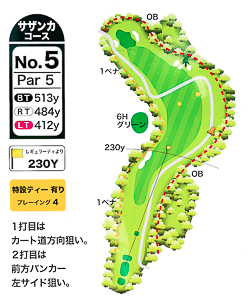Golf
Golf (ゴルフ) is a popular sport in Japan. A large variety of courses for golfers of every budget and skill level can be found across all regions of Japan, with some of the best located around famous resort areas such as Mount Fuji, the Izu Peninsula, Karuizawa and Okinawa, where they offer beautiful mountain views or coastal scenery. Golf can be played year round in Japan except in the snowy regions where courses close in winter.
In past decades, golf was a fairly expensive and exlusive sport in Japan. However, these days a large majority of courses are open to the general public, and it is not uncommon to pay between 7,000 and 12,000 yen per person for an 18-hole round of golf, including lunch and golf cart, especially on regular weekdays. Prices are somewhat higher on weekends, during peak seasons and close to large cities. Rental clubs and caddies may be available for an additional fee although English speaking caddies are rare.

Playing a round of golf in Japan is typically an all-day event with a lunch break of around one hour between the first and second halves of the course. Playing 18 holes without a break in between is possible only at selected courses, except in Hokkaido and Okinawa where it is the norm. At the end of the day, tired golfers head off to the clubhouse to relax in its bath. Towels, soap and shampoo are usually provided, so there is no need to bring your own.
The biggest hurdle for foreign visitors without Japanese knowledge is the difficulty of making reservations at golf courses, as there are only a handful of courses that allow for easy reservations in English. Foreign visitors may try to make reservations via a travel agent or their hotel's concierge, stay at a hotel resort with golf course or check out the foreigner-friendly courses we introduce in our Golf in Japan blog.
In Japanese, there exist two websites that allow for making reservations at most golf courses across Japan. These websites also offer the popular hitori-yoyaku service which allows single players to reserve rounds with other single players at selected courses. Without the use of the hitori-yoyaku system, single players will have difficulties making a reservation at most courses. Groups of two golfers are accepted by most courses these days, but may have to pay a surcharge compared to groups of three or four players.

Rules and etiquette
The rules and etiquette for playing golf in Japan are similar to those in other countries. Most courses enforce a dress code requiring players to wear appropriate golf clothes (typically a collared shirt and slacks or shorts/skirt) while on the course. Some courses may also require jackets to be worn in the clubhouse, so be sure to check ahead of time.
In addition, the following are a few common features likely encountered in Japan:

Yellow flag - a yellow flag or a striped pole is often placed on the fairway at around 230 yards from the regular tees near where a good tee shot would land.
OB tees (two yellow dots on the map) - to speed up play on holes where there is a good chance that balls are played out of bounds or into water from the teeing ground. The OB tees are additional, yellow tee markers placed further down the fairway from where players would take their next shot after having played their ball out of bound or into water on their initial shot.
One-penalty stakes - Another common local rule are black and yellow striped stakes (yellow line on map) that are used to mark an out-of-bounds area (red line). They differ from normal out of bounds markers in that the penalty is only one stroke with your next shot taken from around where your ball crossed the line of the markers.
Where to practice
In addition to the myriad golf courses, there are hundreds of driving ranges found across the country for golf lovers to practice. Typically large constructions wrapped in tall green netting, they can be spotted almost anywhere, even tucked away in the middle of the cities. In many cases, the ranges are two or even three stories high, and many feature automatic teeing machines that can tee up a new ball every few seconds. Driving ranges typically charge around 10 yen per ball, although the price may vary depending on the location, the season or time of day. Some offer practice sessions with unlimited balls for a set amount of time.

Questions? Ask in our forum.


